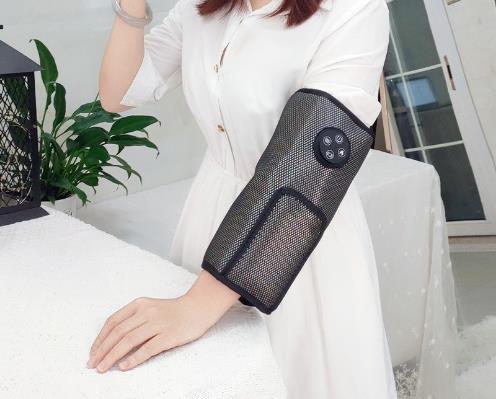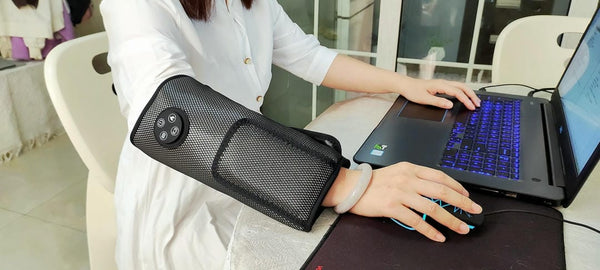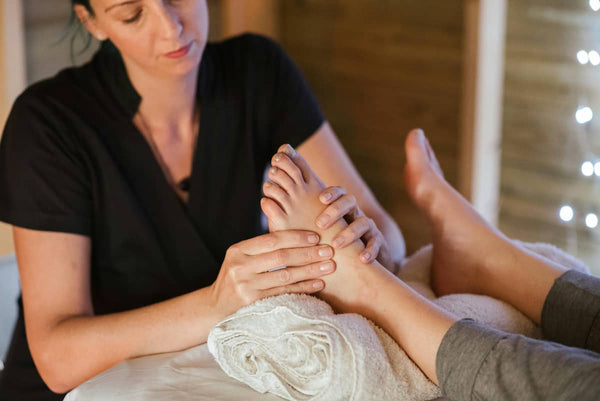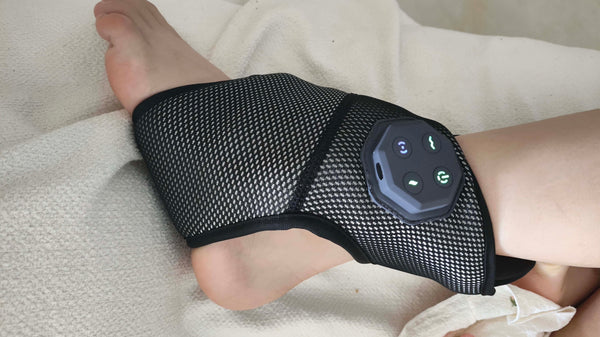 If you're a fitness enthusiast, you know the drill: you push your limits, feel that satisfying burn, and then... ouch. The next day (or two) can be a real battle against stiffness and soreness. You've probably wondered, "Is there a secret weapon to help me bounce back faster?" Many turn to a personal massager, but with so many options, which one truly hits the spot? It's more than just a luxury; for dedicated athletes and weekend warriors alike, the right massager can be a crucial part of a recovery toolkit. This isn't just about feeling good; it's about optimizing your body's ability to repair and rebuild, so you can get back to doing what you love, stronger and sooner.
If you're a fitness enthusiast, you know the drill: you push your limits, feel that satisfying burn, and then... ouch. The next day (or two) can be a real battle against stiffness and soreness. You've probably wondered, "Is there a secret weapon to help me bounce back faster?" Many turn to a personal massager, but with so many options, which one truly hits the spot? It's more than just a luxury; for dedicated athletes and weekend warriors alike, the right massager can be a crucial part of a recovery toolkit. This isn't just about feeling good; it's about optimizing your body's ability to repair and rebuild, so you can get back to doing what you love, stronger and sooner.
We're about to dive into the world of massagers, exploring what makes muscles ache after a tough workout and how these clever devices can come to your rescue. Forget the confusion; we'll break down the science, the types of massagers available, and how to pick the one that'll become your body's new best friend. Ready to turn those groans of pain into sighs of relief? Let's get to it!
Why Your Muscles Scream After a Workout (And Why a Massager Can Be Your Best Friend)
Ever pushed through a killer leg day or an intense HIIT session, only to find yourself wincing with every step the next morning? That, my friends, is often Delayed Onset Muscle Soreness, or DOMS. It's that familiar, sometimes brutal, tenderness that typically peaks 24 to 72 hours after strenuous exercise. What's actually happening in there? Well, intense or new exercises cause microscopic tears in your muscle fibers. This isn't necessarily a bad thing; it's part of the process that leads to muscle growth and strength. However, these micro-tears trigger an inflammatory response, which contributes to the pain and stiffness. Think of it as your body's renovation crew coming in to repair and upgrade – but construction can be noisy and uncomfortable!
Beyond the micro-tears, muscles can also become tight and develop trigger points – those lovely little knots that feel like marbles under your skin. These can restrict movement and cause referred pain. This is where a good massager steps in. It's not just about pampering; it's about actively aiding your body's natural recovery processes. Imagine being able to target that soreness directly, encouraging those muscles to relax and repair more efficiently. Could a device really make that much of a difference? For many, the answer is a resounding "yes!"
- Muscle micro-tears trigger an inflammatory response.
- DOMS typically peaks 24-72 hours post-exercise.
- Tightness and trigger points can restrict movement.
- A massager aims to alleviate these symptoms and support recovery.
Unveiling the Science Behind How Massagers Soothe Sore Muscles
So, how exactly does pummeling or kneading your muscles with a device translate into relief? It's not just voodoo, I promise! Several physiological mechanisms are at play. One of the primary benefits of using a massager is increased blood flow to the targeted area. This is crucial because blood carries oxygen and nutrients essential for muscle repair and helps to flush out metabolic waste products that can accumulate during intense exercise. Think of it like improving the traffic flow on a busy highway – everything moves more smoothly, and deliveries (of good stuff) and pickups (of waste) happen faster. This enhanced circulation can really accelerate the healing process.
Different types of massagers achieve this in slightly different ways. For instance, percussion massagers deliver rapid, concentrated pulses deep into the muscle tissue, which can help break up adhesions (those stubborn knots) and increase circulation dramatically. Other massagers might use kneading motions or vibration, which also stimulate blood flow and help to relax tense muscle fibers. There's also the Gate Control Theory of Pain to consider. Essentially, the sensation of massage can "distract" your brain from pain signals by stimulating other nerve fibers, effectively closing the "gate" to pain. It’s like when you bump your elbow and instinctively rub it – the rubbing sensation helps to override the pain. A truly, truly fascinating aspect of how our bodies work!
- Increased blood flow delivers oxygen and nutrients for repair.
- Helps remove metabolic byproducts from muscle tissue.
- Percussion can break up muscle adhesions and knots.
- Vibration and kneading relax tense muscle fibers.
- Stimulation can interrupt pain signals via the Gate Control Theory.
Concrete Benefits of Using a Massager for Fitness Recovery
While the immediate sensation of relief from a massager is undeniably pleasant, the benefits for fitness enthusiasts go much deeper. We're talking tangible improvements that can impact your training, performance, and overall well-being. Consistently incorporating a personal massager into your routine isn't just a treat; it's a smart strategy for long-term athletic health. From my experience seeing how people integrate recovery tools, the most successful ones are those who understand these underlying advantages.
One of the most sought-after benefits is, of course, reduced muscle soreness and stiffness. By promoting blood flow and helping to dissipate the byproducts of muscle damage, massagers can significantly lessen the severity and duration of DOMS. This means less time feeling like you've been run over by a truck and more time feeling ready for your next challenge. But it doesn't stop there. Improved flexibility and range of motion are also key advantages. Loosening tight muscles and fascia (the connective tissue surrounding your muscles) can help you move more freely and efficiently, potentially reducing your risk of injury. Faster recovery times are a golden ticket for any athlete – and yes, a massager can contribute to that. Let's not forget the mental aspect; reducing physical tension often leads to reduced mental stress, promoting overall relaxation and better sleep, which are also vital for recovery. It's a holistic win!
- Reduced Muscle Soreness and Stiffness: Lessens the impact of DOMS.
- Improved Range of Motion and Flexibility: Loosens tight muscles and fascia.
- Faster Recovery Times: Gets you back to training sooner.
- Enhanced Blood Circulation: Aids in nutrient delivery and waste removal.
- Stress Reduction and Relaxation: Calms the nervous system and can improve sleep.
- Potential Injury Prevention: Addresses muscle imbalances and tightness.
A Fitness Enthusiast's Guide to Different Types of Massagers
 Alright, you're convinced a massager is a good idea. But walk into any store (or browse online), and the sheer variety can be overwhelming! From high-powered "guns" to gentle vibrating pads, how do you pick your perfect match? The key is understanding the main types of massagers and aligning their strengths with your specific needs as a fitness enthusiast. Do you need something to obliterate deep knots, or something more versatile for overall recovery? Let's break down the common contenders.
Alright, you're convinced a massager is a good idea. But walk into any store (or browse online), and the sheer variety can be overwhelming! From high-powered "guns" to gentle vibrating pads, how do you pick your perfect match? The key is understanding the main types of massagers and aligning their strengths with your specific needs as a fitness enthusiast. Do you need something to obliterate deep knots, or something more versatile for overall recovery? Let's break down the common contenders.
First up, we have the heavy hitters: **percussion massagers** (often called massage guns, with brands like Theragun being well-known examples). These devices are favored for deep tissue massage, delivering rapid, targeted pulses into the muscle. Perspective 1 rightly points out their efficacy for this. They're fantastic for breaking up stubborn knots, relieving serious muscle tension, and are often preferred by athletes needing intense relief. On the other hand, **multi-functional massagers** (like the Klcosy Massager mentioned in Perspective 2 and 3) offer a broader range of applications. These often combine different massage modes like kneading, vibration, and sometimes even heat. Their adjustable intensity makes them suitable for everything from gentle, soothing relief to a stronger, more invigorating massage. Perspective 3 highlights their portability and adjustable modes, which can be a huge plus for fitness enthusiasts who might want to take their massager to the gym or while traveling. They can be a great all-rounder, especially if you're looking for versatility. Don't forget simpler tools like foam rollers and massage balls – while manual, they are effective for self-myofascial release, especially for larger muscle groups. When looking for massagers, consider these types.
-
Percussion Massagers:
- Best for: Deep tissue work, targeting specific knots, intense relief.
- Consideration: Can be quite powerful; start gentle.
-
Multi-functional Massagers:
- Best for: Versatile use, adjustable intensity (gentle to strong), various massage styles (kneading, vibration, heat), portability.
- Consideration: Might not offer the same pinpoint intensity as a high-end percussion gun for very deep knots, but excellent for overall recovery and varied needs.
-
Foam Rollers/Massage Balls:
- Best for: General myofascial release, large muscle groups, budget-friendly.
- Consideration: Requires manual effort and learning techniques.
-
Handheld Vibrating Massagers:
- Best for: General relaxation, surface-level muscle soothing.
- Consideration: Typically less intense than percussion or comprehensive multi-functional units.
Master Your Massage: Pro Tips for Effectively Using Your Personal Massager
So you've chosen your massager. Fantastic! But just like any piece of fitness equipment, knowing how to use it properly is key to unlocking its full potential and, importantly, avoiding any boo-boos. It’s not just about turning it on and going wild; a little technique goes a long way. Think of it as learning the nuances of **how to give a massage** to yourself effectively and safely. The goal is to feel better, not worse, right?
First and foremost, always listen to your body. Start with a lower intensity setting and gradually increase it as your muscles warm up and you get accustomed to the sensation. More is not always better, especially when you're starting out. Avoid using your massager directly on bones, joints, or your spine – stick to the fleshy parts of your muscles. If you hit a spot that causes sharp pain, ease off or move to a different area. Consistency can be more beneficial than one super-intense session; incorporating short massage periods regularly into your pre-workout warm-up or post-workout cool-down can yield significant benefits. Before you even buy, doing a bit of homework by checking **massage reviews** for the specific models you're considering can provide invaluable insights from other users. This helps you understand real-world performance and durability. Some people find a light massage pre-workout helps to "wake up" the muscles, while most use it post-workout to kickstart recovery. Experiment and see what feels best for your body and routine!
- Start Gentle: Always begin with the lowest intensity and gradually increase.
- Avoid Bones and Joints: Focus on muscle bellies. Never massage directly over the spine.
- Listen to Your Body: "Good pain" is okay, sharp or unbearable pain is not. Ease off if it hurts too much.
- Stay Hydrated: Drink plenty of water, as massage can help release toxins.
- Be Consistent: Short, regular sessions are often more effective than infrequent long ones.
- Consider Timing: Use for 1-2 minutes on a muscle group pre-workout for activation, or longer post-workout for recovery.
- Read Instructions: Your specific massager will come with guidelines – read them!
- Research: Check massage reviews for user experiences before purchasing any massagers.
Finding Your Perfect Recovery Partner
Choosing the right massager isn't just about alleviating aches; it's an investment in your fitness journey, helping you recover faster, perform better, and stay consistent with your training. Whether you lean towards the intense, deep-tissue relief of a percussion massager or the adaptable, soothing comfort of a multi-functional device, the best personal massager is the one that meets your specific needs and you'll use regularly. As someone who has seen the evolution of these devices, it's clear that innovations are continually striving to make effective recovery more accessible and personalized.
Remember to consider your typical workout intensity, your main soreness culprits, and whether features like portability or varied massage modes are important to you. Don't be afraid to explore different types and integrate this powerful tool into your wellness routine. Your muscles will thank you for it, and you might just find that your recovery game reaches a whole new level. Here's to less soreness and more gains!
Frequently Asked Questions (FAQ)
What are the most recommended massagers for general use?
For general use, especially for fitness enthusiasts looking for a balance of relief and versatility, multi-functional massagers are often highly recommended. These devices typically offer various modes (like kneading, vibration, sometimes heat) and adjustable intensity levels, making them adaptable to different needs – from gentle relaxation to more robust muscle work. Percussion massagers are excellent for deep, targeted relief but can be intense for some. If you're unsure, a good quality multi-functional massager often provides the best all-around value and utility. Reading massage reviews can also help identify popular and well-regarded models for general applications.
How to compare massagers by brand and price?
Comparing massagers involves looking beyond just the price tag. Consider the type of massage mechanism (percussion, shiatsu, vibration, etc.), intensity levels, number and type of attachments, battery life (for cordless models), warranty, and brand reputation. Cheaper, unknown brands might be tempting, but they may lack durability or effective power. Established brands often have more R&D behind their products and better customer support. Read independent massage reviews and watch video comparisons. When comparing, check online massage reviews, brand reputation, and consider if you want to test models; some specialty stores might offer massagers near me for a hands-on feel, though online retailers often have wider selections and competitive pricing. Set a budget, but be prepared to invest a bit more for quality and features that genuinely meet your recovery needs.
Are massagers safe for daily use?
For most healthy individuals, using a massager daily is generally safe, provided it's used correctly and doesn't cause pain. Short sessions of 10-15 minutes on different muscle groups are typically fine. However, it's crucial to listen to your body. If you experience bruising, increased pain, or irritation, reduce the frequency or intensity, or take a break. Certain conditions (like deep vein thrombosis, open wounds, severe osteoporosis, pregnancy – especially abdominal massage) may contraindicate massager use, or require a doctor's consultation. If you have any underlying health concerns, it's always best to check with your healthcare provider before incorporating a personal massager into your daily routine. Remember, the goal is therapeutic benefit, not to cause harm.




0 comments